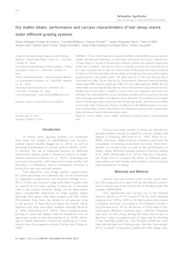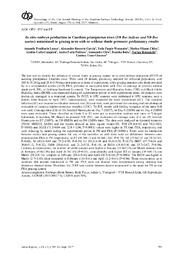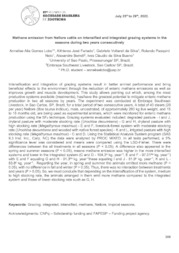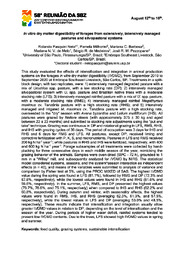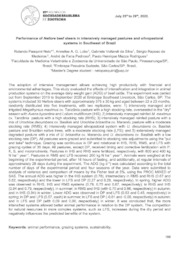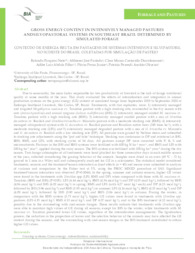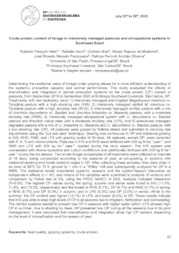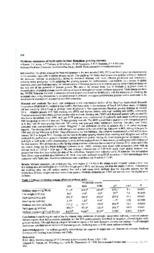Search Publications
Filter by:
| Author(s): SANTOS, V. R. V. dos; McNANUS, C.; PERIPOLLI, V.; TANURE, C. B.; LIMA, P. de M. T.; CORRÊA, P. S.; BRITO, D. L.; TORRES, S. E. F. de A.; LOUVANDINI, H. The aim of this study was to evaluate the effect of three different grazing systems: isolated, alternate and simultaneous, on feed intake, performance and carcass characteristics of sheep. About 5.2 h... ... |
| Author(s): LEMES, A. P.; GARCIA, A. R.; WATANABE, Y. F.; CHIBA, M. O.; CAMPLESI, A. C.; PEDROSO, A. de F.; GIRO, A.; BOTTA, D.; ROMANELLO, N.; GIMENES, L. U.
|
| Author(s): LOBO, A. A. G.; FURTADO, A. J.; SILVA, G. V. DA; PASQUINI NETO, R.; BERNDT, A.; BUENO, I. C. DA S. Intensification and integration of grazing systems result in better animal performance and bring beneficial effects to the environment through the reduction of enteric methane emissions as well as imp... ... |
| Author(s): PASQUINI NETO, R.; PÁDUA, G. S. DE; MELO, N. N. V. DE; FURTADO, A. J.; MEDEIROS, S. R. de; RODRIGUES, P. H. M. This study evaluated the effects of intensification and integration in animal production systems on the feed conversion ratio (FCR) of beef cattle. |
| Author(s): PASQUINI NETO, R.; MILHORINI, P.; BARBOSA, M. C.; MELO, M. N. V. DE; MEDEIROS, S. R. de; PEZZOPANE, J. R. M. Methane gas (CH4), associated with climate change, is produced in the soil by anaerobic microorganisms. These decompose the carbon present in organic matter and convert it into CH4. |
| Author(s): PASQUINI NETO, R.; LOBO, A. A. G.; SILVA, G. V. DA; MEDEIROS, S. R. de; PEDROSO, A. de F.; RODRIGUES, P. H. M. The adoption of intensive management allows achieving high productivity with financial and environmental advantages. |
| Author(s): PASQUINI NETO, R.; LOBO, A. A. G.; SILVA, G. V. DA; COLOSSO, L. A.; PEDROSO, A. de F.; RODRIGUES, P. H. M. The adjustment of stocking rates of production systems is a technique used to increase animal productivity per area, by defining the availability of forage mass per animal in a predefined time. |
| Author(s): PASQUINI NETO, R.; FURTADO, A. J.; DIAVOLEMENOS, C. M. C.; ABDALA FILHO, A. L.; PERNA JÚNIOR, F.; OLIVEIRA, P. P. A. Due to seasonality, the main factor responsible for low productivity of livestock is the lack of forage nutritional quality in some months of the year. |
| Author(s): PASQUINI NETO, R.; VECHI, R.; BOSI, C.; MEDEIROS, S. R. de; PEZZOPANE, J. R. M.; OLIVEIRA, P. P. A. Determining the nutritional value of forage under grazing allows for a more efficient understanding of the system?s productive capacity and animal performance. |
| |
Observation
Some of Embrapa's publications are published as ePub files. To read them, use or download one of the following free software options to your computer or mobile device. Android: Google Play Books; IOS: iBooks; Windows and Linux: Calibre.
Access other publications
Access the Agricultural Research Database (BDPA) to consult Embrapa's full library collection and records.
Visit Embrapa Bookstore to purchase books and other publications sold by Embrapa.

